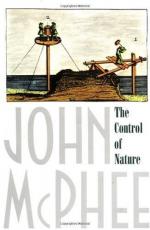
|
| Name: _________________________ | Period: ___________________ |
This test consists of 15 multiple choice questions and 5 short answer questions.
Multiple Choice Questions
1. Over a number of centuries, how does the Mississippi River form the state of Louisiana?
(a) By creating all of the state's boundaries.
(b) By cutting deep, rocky canyons into the land.
(c) By irrigating carefully cultivated fields.
(d) By overflowing river banks.
2. In feet, how long is the towboat Mississippi?
(a) 459.
(b) 23.
(c) 217.
(d) 42.
3. Atchafalaya is a what?
(a) River.
(b) Mountain.
(c) Waterfall.
(d) City.
4. A towboat is designed to:
(a) Pull large cargo ships.
(b) Push large cargo ships.
(c) Pull barges.
(d) Push barges.
5. In 1928, Congress enacts the Flood Control Act to start what?
(a) Mississippi River and Tributaries Project.
(b) Atchafalaya River and Levees Project.
(c) Old and New Rivers Effort.
(d) Rivers, Tributaries, and Levees Effort.
6. In the mid-1800s, the United States Congress passes a Swamp and Overflow Land Act to:
(a) Create a new water control system.
(b) Take away ownership rights.
(c) Evict land squatters.
(d) Deed swampland to individual states.
7. Sympathetically, who does McPhee blame for destructive actions against the natural order of the environment?
(a) Man.
(b) The United Nations.
(c) The Executive branch of government.
(d) Foreign policy.
8. A navigation lock on the bank of the Mississippi River lowers ships down to where?
(a) Red River.
(b) Gulf of Mexico.
(c) Atchafalaya River.
(d) Atlantic Ocean.
9. The author states that how much of New Orleans lies fifteen feet below sea level?
(a) One quarter.
(b) Ten percent.
(c) All of it.
(d) Half.
10. What does James B. Eads invent to explore the Mississippi River?
(a) Submarine.
(b) Glass-bottom boat.
(c) Underwater camera.
(d) Water telescope.
11. Every thousand years or so, the Mississippi River goes through a major shift that leaves behind what?
(a) Dry mudflats.
(b) Stranded bird colonies.
(c) Large, deep saltwater lakes.
(d) Bayous and natural levees.
12. The livelihood of approximately how many people is affected by the Old River Control?
(a) 3 thousand.
(b) 3 million.
(c) 31 thousand.
(d) 13 hundred.
13. During the fifty years between New Orleans' floods of 1735 and 1785, what does the author say brings a false sense of security against flooding?
(a) Extended, raised levees.
(b) Drought conditions.
(c) Prosperous economic boom.
(d) Concrete seawalls.
14. What river does the author mention that connects the Atchafalaya and the Mississippi to form an H?
(a) Red River.
(b) New River.
(c) Black River.
(d) Old River.
15. When floodwaters cover twenty-six thousand square miles in 1927, how is New Orleans saved?
(a) Layering sandbags along the riverbanks.
(b) Quickly digging a diversion channel.
(c) Blowing up a downstream levee.
(d) Building concrete walls around the city.
Short Answer Questions
1. A snagboat is a river boat that does what?
2. What does Major General Thomas Sands do each year on the Mississippi in late summer or early fall?
3. Norris F. Rabalais was born and raised in what Louisiana parish?
4. By 1812, the east bank of the Mississippi River is levied up to which city?
5. What does the 1927 flood in Louisiana teach officials about levees?
|
This section contains 507 words (approx. 2 pages at 300 words per page) |

|




